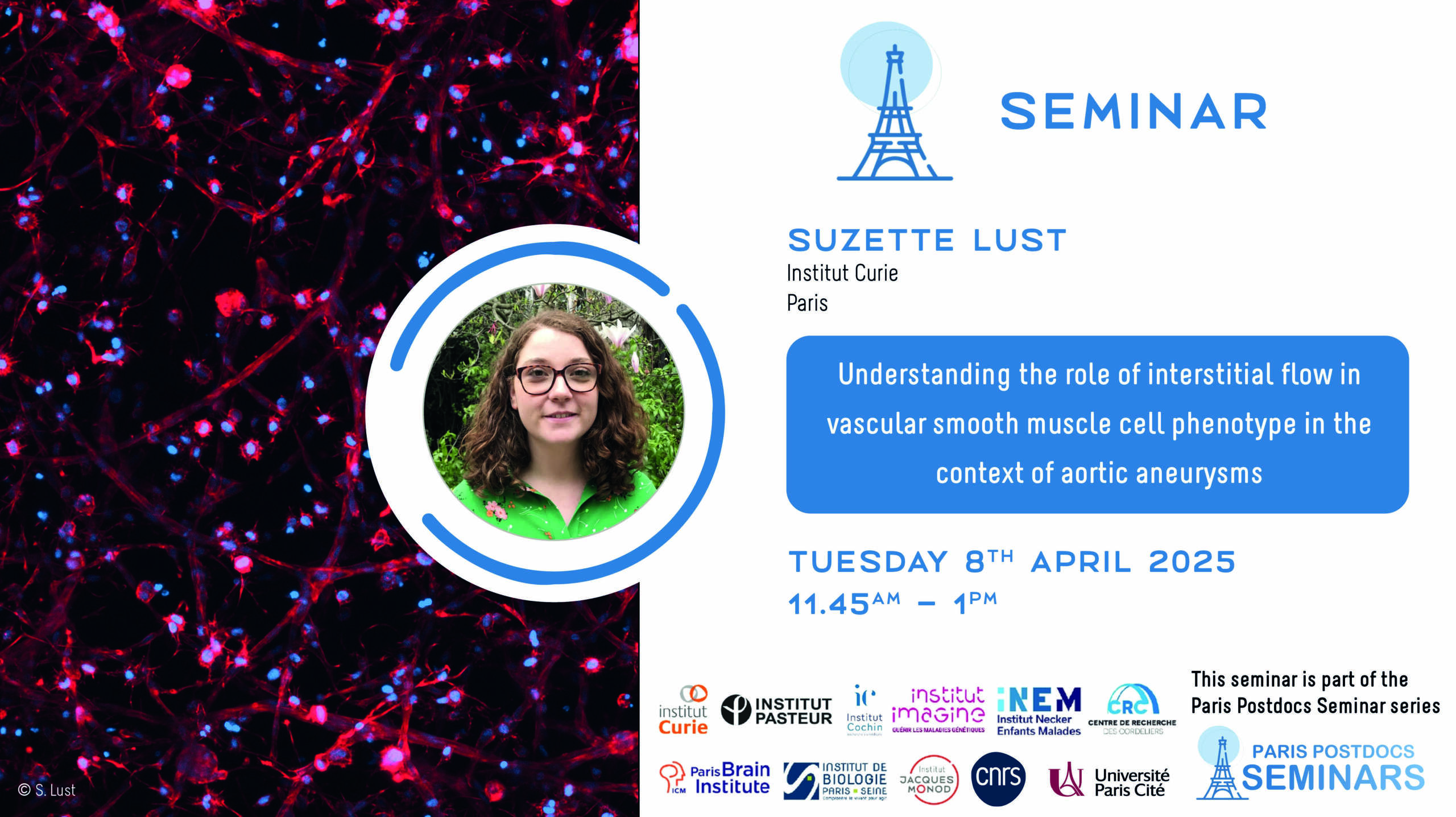
Seminaire – Suzette Lust
8 avril 2025 - 11 h 45 min - 13 h 00 min

Invitée par l’Institut Jacques Monod, Suzette Lust (Postdoctoral researcher in Danijela Matic Vignjevic’s team – Cell migration and invasion Laboratory at Institut Curie) va présenter le séminaire sur le thème :
Understanding the role of interstitial flow in vascular smooth muscle cell phenotype in the context of aortic aneurysms
Ce séminaire se déroule dans le cadre des Paris Postdocs Seminars.
Résumé :
Aortic aneurysms are abnormal enlargements of blood vessel diameter caused by aberrant extra-cellular matrix (ECM) remodelling. As the tissue dilates, it loses its mechanical integrity, exposing patients to risk of highly fatal aortic dissections or ruptures. This is mediated in part by phenotypic switching and or apoptosis of the intima-resident vascular smooth muscles (VSMCs). What drives this pathology is not well understood, particularly in the case of aneurysms in Bicuspid Aortic Valve disease (BAV) patients, a congenital condition characterised by the malformation of the aortic valve resulting in only 2 leaflets. Improvements in imaging techniques have now allowed pathological blood flow patterns to be correlated to aneurysm morphology and indeed there is increasing evidence that mechanotransduction from flow may be a driver of aneurysm development. Blood flow imparts mechanical forces to cells through stretching and frictional shear forces and we are focused here on the interstitial flow driven into the wall by differential pressure gradients within the aorta.
We hypothesise that interstitial flow plays a crucial role in regulating VSMC phenotype and ECM interactions and that this may be used to correlate disrupted flow patterns seen in BAV patients to the morphology changes in their aortas.
To test this hypothesis, we created a reductionist in-vitro model culturing VSMCs in 3D under interstitial flow. We combined a synthetic PEG based ECM mimicking hydrogel with primary cultures of VSCMs with a microfluidics setup.
We showed hydrogels doctored with degradable bioactive peptides could be broken down by exogenous and cell derived MMPs. We measured hydrogel permeability using 2 separate techniques which confirmed the material to have a low permeability compared to other standard hydrogels, on the order of 10−16 m2. Furthermore, we characterised mass transport of solutes within hydrogels and were able to demonstrate a negligible impact of changing polymer solid content on diffusivity in hydrogels of up to 5% weight/volume for molecules up to 40 kDa in size. Via production of MMPs, VSMCs break down the hydrogel and importantly by day 7 of culture, we detected newly synthesised fibronectin, collagen 1 and 4 proteins. We stimulated encapsulated cells with interstitial flows demonstrating that cells align to the flow direction. Finally, we performed RNA sequencing on 3 human patient samples comparing standard culture conditions, non-flow stimulated encapsulated cells and interstitial-flow stimulated cells. The data set reveals significant upregulation of genes in multiple pathways associated with cyclic AMP production, which plays a crucial role in regulating VSMC contractility and calcium signalling and hence phenotype. The data suggests that this is mediated via activation of G-protein receptors leading to increased expression of adenylyl cyclase but this remains to be confirmed.
In conclusion, we developed a novel in-vitro platform to study the impact of interstitial flow on VSMC behaviour. Our data suggests that interstitial flow may play a regulating role in determining VSMC phenotype with potential consequences for matrix remodelling in disease.

